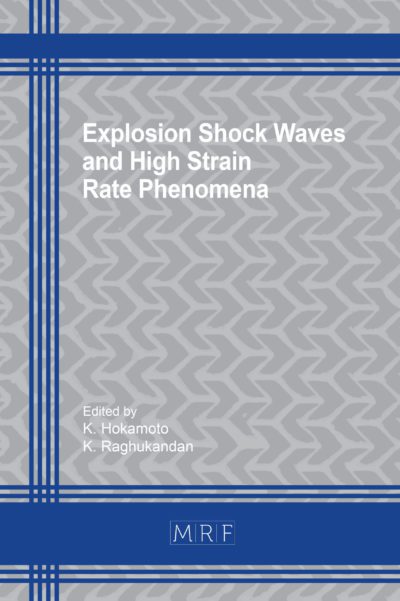Development of Weldability Window for Aluminum-Steel Explosive Cladding
G. Murugan, S. Saravanan, K. Raghukandan
download PDFAbstract. This study addresses the development of biaxial and triaxial weldability window- an analytical estimation-for determining the nature of interface in aluminum 5052-stainless steel 304 dissimilar explosive cladding. The lower and upper boundaries of the biaxial weldability window are formulated using empirical relations proposed by earlier researchers. The process parameters – dynamic bend angle and collision velocity are chosen as ordinates and abscissa respectively. In addition, a triaxial weldability window, comprising of three process parameters viz., flyer plate velocity, collision velocity and dynamic bend angle is also developed. Explosive cladding experiments were conducted by varying the process parameters and the interface microstructure is correlated with the developed weldability windows.
Keywords
Explosive Cladding, Aluminum, Stainless Steel, Weldability Window, Microstructure
Published online 7/30/2019, 5 pages
Copyright © 2019 by the author(s)
Published under license by Materials Research Forum LLC., Millersville PA, USA
Citation: G. Murugan, S. Saravanan, K. Raghukandan, Development of Weldability Window for Aluminum-Steel Explosive Cladding, Materials Research Proceedings, Vol. 13, pp 154-158, 2019
DOI: https://doi.org/10.21741/9781644900338-26
The article was published as article 26 of the book Explosion Shock Waves and High Strain Rate Phenomena
![]() Content from this work may be used under the terms of the Creative Commons Attribution 3.0 licence. Any further distribution of this work must maintain attribution to the author(s) and the title of the work, journal citation and DOI.
Content from this work may be used under the terms of the Creative Commons Attribution 3.0 licence. Any further distribution of this work must maintain attribution to the author(s) and the title of the work, journal citation and DOI.
References
1. Y.Aizawa, J. Nishiwaki,, Y.Harada, S.Muraishi,. and S.Kumai, 2016. Experimental and numerical analysis of the formation behavior of intermediate layers at explosive welded Al/Fe joint interfaces. Journal of Manufacturing Processes, 24, pp.100-106. https://doi.org/10.1016/j.jmapro.2016.08.002
2. S.Saravanan. and K.Raghukandan, 2011. Energy dissipation in explosive welding of dissimilar metals. Materials Science Forum, 673, pp. 125-129. https://doi.org/10.4028/www.scientific.net/msf.673.125
3. F.Findik, 2011. Recent developments in explosive welding. Materials & Design, 32(3), pp.1081-1093. https://doi.org/10.1016/j.matdes.2010.10.017
4. Satyanarayan, A.Mori, M.Nishi. and K.Hokamoto, 2019. Underwater shock wave weldability window for Sn-Cu plates. Journal of Materials Processing Technology, 267, pp.152-158. https://doi.org/10.1016/j.jmatprotec.2018.11.044
5. X.Wang, Y.Zheng, H.Liu, Z.Shen, Y.Hu, W.Li, Y.Gao. and C.Guo., 2012. Numerical study of the mechanism of explosive/impact welding using smoothed particle hydrodynamics method. Materials & Design, 35, pp.210-219. https://doi.org/10.1016/j.matdes.2011.09.047
6. S.Somasundaram, R.Krishnamurthy. and H.Kazuyuki 2017. Effect of process parameters on microstructural and mechanical properties of Ti− SS 304L explosive cladding. Journal of Central South University, 24(6), pp.1245-1251 https://doi.org/10.1007/s11771-017-3528-3
7. S.Saravanan. and K.Raghukandan, 2012. Thermal kinetics in explosive cladding of dissimilar metals. Science and Technology of Welding and Joining, 17(2), pp.99-103. https://doi.org/10.1179/1362171811y.0000000080
8. S.Saravanan and K.Raghukandan, 2013. Influence of interlayer in explosive cladding of dissimilar metals. Materials and Manufacturing Processes, 28(5), pp.589-594. https://doi.org/10.1080/10426914.2012.736665
9. S.A.Mousavi. and P.F.Sartangi, , 2009. Experimental investigation of explosive welding of cp-titanium/AISI 304 stainless steel. Materials & Design, 30(3), pp.459-468. https://doi.org/10.1016/j.matdes.2008.06.016
10. P.Tamilchelvan, K.Raghukandan. and S.Saravanan, 2014. Kinetic energy dissipation in Ti-SS explosive cladding with multi loading ratios. Iranian Journal of Science and Technology. Transactions of Mechanical Engineering, 38(M1), p.91-96.
11. S.Saravanan, K.Raghukandan. and K.Hokamoto, 2016. Improved microstructure and mechanical properties of dissimilar explosive cladding by means of interlayer technique. Archives of Civil and Mechanical Engineering, 16(4), pp.563-568. https://doi.org/10.1016/j.acme.2016.03.009
12. I.A.Bataev, D.V.Lazurenko, S.Tanaka, K.Hokamoto, A.A.Bataev, Y.Guo. and A.M.Jorge Jr 2017. High cooling rates and metastable phases at the interfaces of explosively welded materials. Acta Materialia, 135, pp.277-289. https://doi.org/10.1016/j.actamat.2017.06.038














